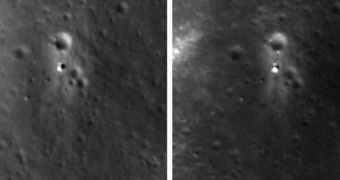Officials with the American space agency announced recently that the NASA Lunar Reconnaissance Orbiter (LRO) has thus far been able to image the landing site of China's first lunar lander and rover mission three times. The differences the cameras see can be used to assess changes at the Mare Imbrium site.
The Chinese National Space Administration (CNSA) managed to land its first powered spacecraft on the Moon on December 14, 2013, in an area known as the Sea of Rains (Mare Imbrium). The lander, Chang'e-3, then successfully deployed the six-wheeled Yutu rover, also called Jade Rabbit.
Since then, the LRO Camera (LROC) instrument managed to photograph that location on December 25, 2013, January 21, 2014, and February 17. The image above also includes a photo snapped of the target site before the CNSA mission arrived, back on June 30, 2013.
The differences in illumination between the inset images B through D is produced by a steady decline of the solar incidence angle over Mare Imbrium, from 77 degrees to 45 degrees. For comparison, this angle is 0 degrees at noon, and 90 percent at dusk.
Lower incidence angle images allow for more contrast, which is why the tiny tracks left on the lunar surface by Yutu are more clearly visible in the last image of this set. Next month, an increasing angle is expected to reveal numerous subtle landscape features around Chang'e-3.

 14 DAY TRIAL //
14 DAY TRIAL //